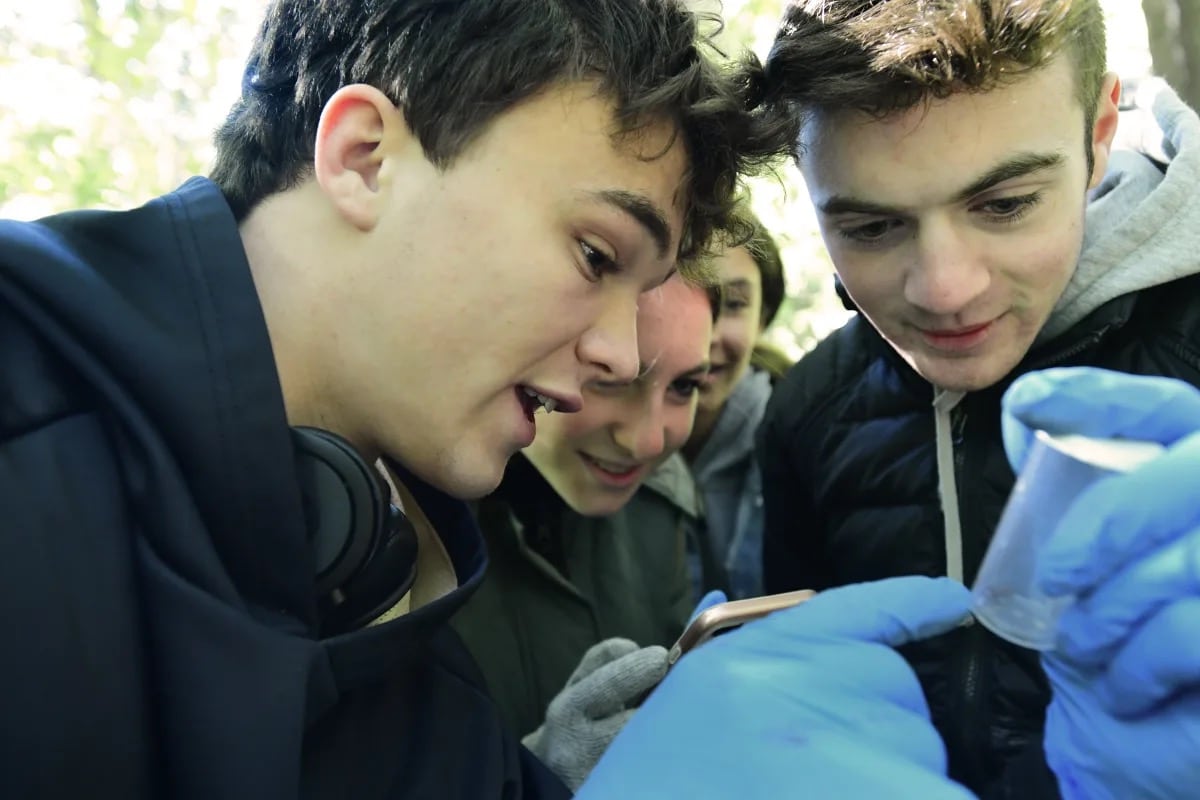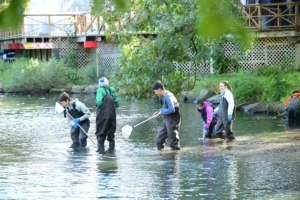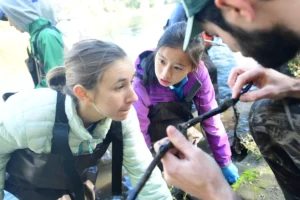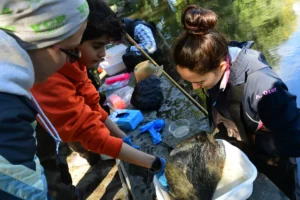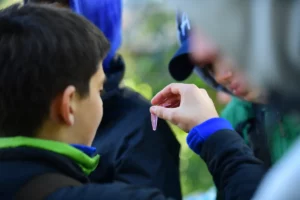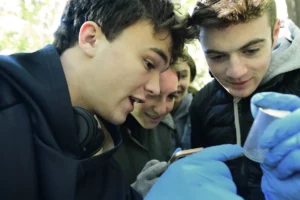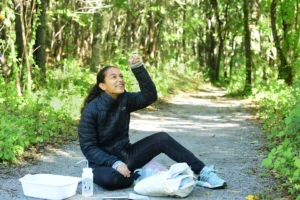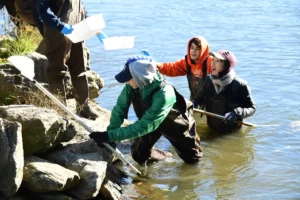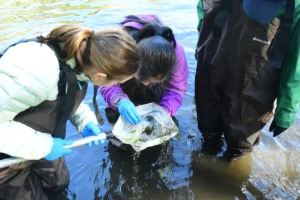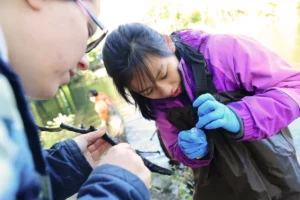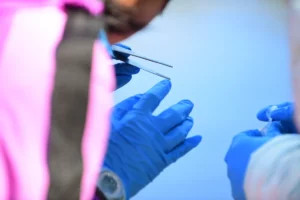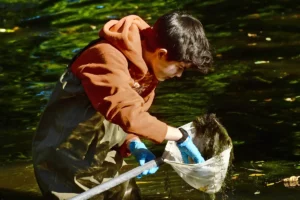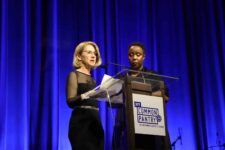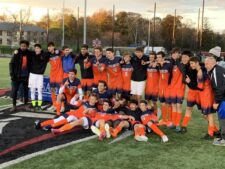It’s a crisp October morning in Van Cortlandt Park. At 10:30am on a Thursday, the park is mostly quiet, save for the hooting and hollering coming from a grove of trees. Fieldston 10th Graders Gregory H. and Jacob H. are high-fiving, while their colleagues Mira G. and Taja G. clap their hands together excitedly. The students are celebrating because they’ve successfully caught a sowbug killer spider — one that is five times larger than the other spiders captured this morning. In many contexts, a larger spider would elicit shouts of a different kind, but for these young scientists, it means they’ll have a slightly easier time examining the specimen and, a few weeks from now, extracting its DNA.
This fieldwork is a typical part of Fieldston’s Science Research Program, which provides advanced research opportunities for interested high school students.
Typical — and meaningful. “A lot of the time with experiments, you’ll get chemicals from a lab, or maybe you’ll make it but from something you got shipped to you,” says Rachel H. ’21. “But here, being able to pick out the things from the water that you need — it’s kind of remarkable. I’m sure at the end of the experiment, it will be really cool to know that we did every step, from the very beginning.”

Embracing the full scope of experiments, and getting hands-on experience with each part of the process, is core to the program itself. “We witness our students turning into scientists,” says Howie Waldman, science teacher and founder of the Science Research Program. “By the end of the first year, students are able to accomplish different advanced techniques successfully. DNA extraction, DNA amplification (PCR), gel electrophoresis — students do that all themselves.”
Before a student can even join the program, they need to apply — this year, only half of applicants were accepted. The application process includes a questionnaire, which asks students to explain why they want to be in the program, and also asks them to talk about something they are passionate about, be it science related or not. “Students don’t need to have taken intensive science previously, but they need to show a passion for science.” Explains Dr. Annie Kloimwieder, who also teaches in the Science Research program. “Some kids are really excited about science. Those are the kids we want.”

Year one of the Science Research Program begins with learning advanced laboratory techniques, such as how to use a micropipette to measure very precise amounts of liquid (down to 10 millionths of a liter). The students also learn to use a centrifuge — a machine that spins materials at high speed in order to separate protein from DNA — and a PCR machine, which amplifies the separated DNA. Students will use these tools to extract and analyze DNA from the specimens they collect in Van Cortlandt Park.
Besides performing advanced laboratory experiments, students also spend the first year of the program planning their independent summer project in a research lab, where they will collect data to analyze in the second year of the program. The summer after year one is one of the most distinctive aspects of the entire program — and most rewarding, some say. Students have the opportunity to do research in a real lab, a rare experience for high schoolers. During her summer lab placement, Serena Z. ’19 studied glaciation at the Lamont-Doherty Earth Observatory at Columbia University. Megan R. ’19 tested whether native fungi can be used to remediate asphalt pathways. Dahlia G. ’18 traveled to Africa to study the water quality in four Kenyan cities. These are just a few of the many dynamic, rigorous, and often groundbreaking projects that students in the Science Research Program complete.
Back in the park, students are reminded by Alex, a scientist and educator, to return upturned rocks to their original positions — “It takes hundreds of years for rocks to settle on the ground,” he says. “Let’s make sure we leave everything as we found it.” (This won’t be the last ethical note of the day: several students bring up how pesticides from the nearby golf course may be harming the plant and animal life, and how they might be able to study this more closely.)
Alex is leading the students today as a member of Friends of Van Cortlandt Park, a local nonprofit that brings students and community members into the park for environmental stewardship programs. Our students’ work will not only bolster their own scientific skills, but provide vital insight into the park’s wildlife that will be used by Friends of Van Cortlandt and the NYC Department of Parks and Recreation to help manage species diversity throughout New York City.
There is a wonderful feeling of community and teamwork amongst the class as they work. Students wading in Van Cortlandt Lake call to one another across the water, celebrating discoveries and offering tips on where to look to find more creatures. Students who are looking for snails stumble across a few leeches and offer to help their classmates collect them.
Sometimes you don’t get any data, and that’s okay. You still learn things, you eliminate possibilities. You learn about the nature of science.
Dr. Annie Kloimwieder
Once creatures are gathered, students will return to campus and begin to catalog their specimens. They’ll use the centrifuge and PCR machines, then they will carefully extract DNA. The DNA will then be sent off to be sequenced before students can analyze the data. In addition to their partners at Van Cortlandt Park, the Science Research Program works with the Urban Barcode Project to identify and catalogue species diversity. The UBP provides critical expertise and lab materials, as well as the opportunity to collaborate with students across New York City.
“The Science Research program teaches hands-on science.” Says Dr. Kloimwieder. “The students are not just hearing about it; everything is about doing. It’s about the excitement of scientific study. Learning and being okay with failure — that’s a bigger part of science as a whole. Sometimes you don’t get any data, and that’s okay. You still learn things, you eliminate possibilities. You learn about the nature of science.”
Rachel H. echoed this idea of learning to fail. “Science is 99% errors,” she said as the students wrapped up their time at Van Cortlandt Park. Despite struggling to find any dragonfly nymphs in the lake, she never seemed frustrated or defeated. “Most science doesn’t result in anything. It’s a lot of chance.”
Asked why we study it, then, Rachel paused for a moment, her eyes still on the pile of algae in her hands. She looked up, as if the answer should be obvious. “For that one percent.”
